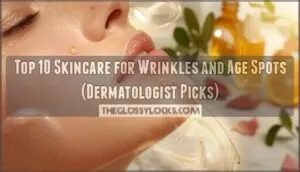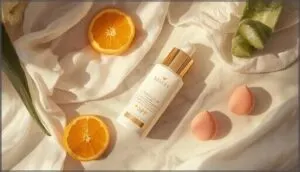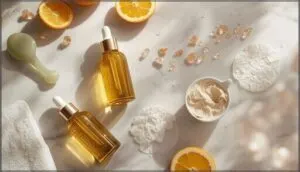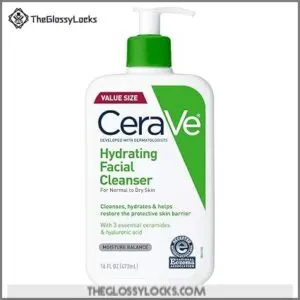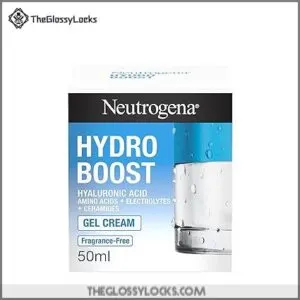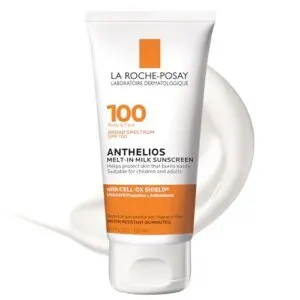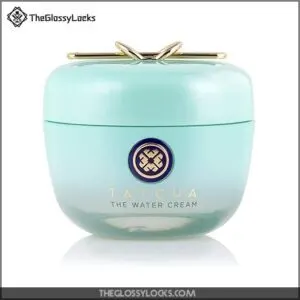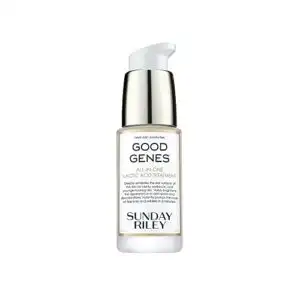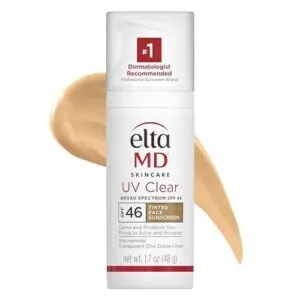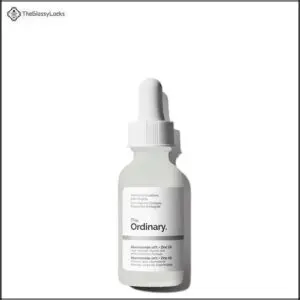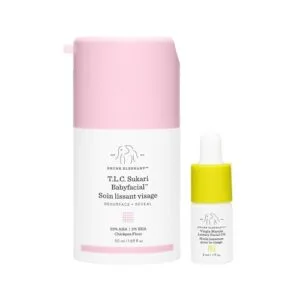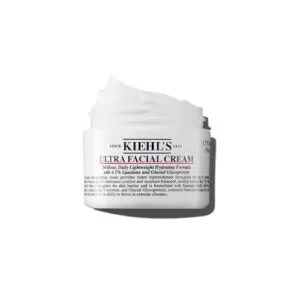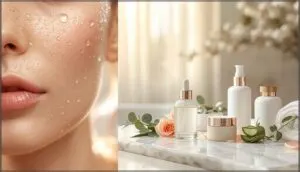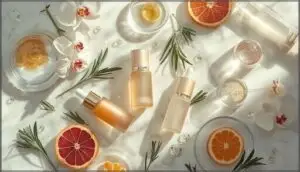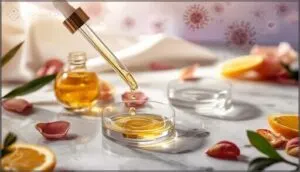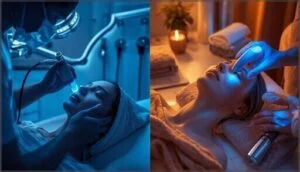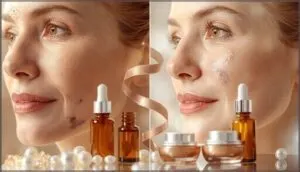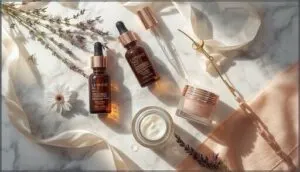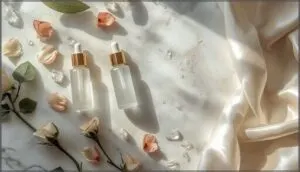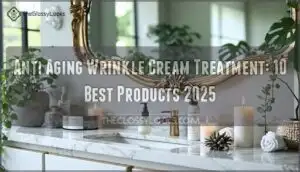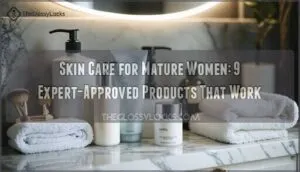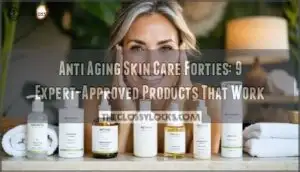This site is supported by our readers. We may earn a commission, at no cost to you, if you purchase through links.
Your skin tells a story, and wrinkles and age spots are often the plot twists you didn’t sign up for. While genetics load the gun, sun exposure pulls the trigger—accounting for up to 80% of visible facial aging.
The good news? Modern skincare for wrinkles and age spots combines clinically proven ingredients like retinol, vitamin C, and niacinamide to rewrite that narrative. You don’t need a 12-step routine or a dermatologist’s budget to see real results.
What you do need is the right combination of actives that target collagen breakdown, melanin overproduction, and moisture loss. The products ahead represent the intersection of solid science and real-world effectiveness, giving you a practical roadmap to smoother, more even-toned skin.
Table Of Contents
- Key Takeaways
- Essential Skincare Routine for Aging Skin
- Key Ingredients to Target Wrinkles and Age Spots
- Best Practices for Sun Protection and Prevention
- Exfoliation and Brightening Methods
- Top 10 Skincare Products for Wrinkles and Age Spots
- 1. CeraVe Hydrating Facial Cleanser For Dry Skin
- 2. Neutrogena Hydro Boost Gel Cream
- 3. La Roche Posay SPF 100
- 4. TATCHA Water Cream Lightweight Moisturizer
- 5. Sunday Riley Good Genes Treatment
- 6. Paulas Choice BHA Liquid Exfoliant
- 7. EltaMD UV Clear Tinted Sunscreen
- 8. The Ordinary Niacinamide Blemish Serum
- 9. Drunk Elephant Babyfacial Exfoliating Mask
- 10. Kiehls Ultra Facial Cream Squalane Moisturizer
- Moisturizing and Hydration Strategies
- Dark Spot Correction and Hyperpigmentation Treatments
- Skincare Advice for Different Skin Types
- Expert Insights and Latest Skincare Innovations
- Frequently Asked Questions (FAQs)
- Conclusion
Key Takeaways
- Sun exposure causes up to 80% of visible facial aging, making daily broad-spectrum SPF 30+ your most effective defense against both new wrinkles and age spots—far more impactful than any treatment product alone.
- Retinoids, vitamin C, niacinamide, and hyaluronic acid are the clinically proven heavy hitters for aging skin, with retinol showing up to 87.5% wrinkle reduction when combined with peptides and consistent use over 12 weeks.
- Chemical exfoliants like AHAs and BHAs can reduce wrinkles by over 32% and fade dark spots by 75% in clinical trials, but aging skin needs gentler frequencies—limit to once or twice weekly to avoid barrier damage and irritation.
- Layering products from thinnest to thickest (serum, then moisturizer) and applying hydrating ingredients on damp skin boosts absorption by up to 48%, making your routine more effective without buying more products.
Essential Skincare Routine for Aging Skin
Aging skin needs a consistent, thoughtful routine to address wrinkles and age spots effectively. The right sequence of steps helps your products work better and protects your skin from further damage.
Here’s how to build a daily routine that targets visible signs of aging while keeping your skin healthy.
Daily Cleansing Steps for Mature Skin
Start your anti-aging skin care routine with the right cleansing frequency—dermatologists recommend cleansing once or twice daily based on your skin’s sensitivity. Choose a low-pH, sulfate-free formulation with ceramides or glycerin to protect your barrier and prevent moisture loss. Use lukewarm water and gentle upward motions during facial cleansing.
A good routine should also include consistent use of products for best results. These expert techniques reduce wrinkle impact while supporting healthier, more resilient mature skin.
Importance of Toning and PH Balance
After cleansing, your skin’s pH shifts alkaline—healthy skin maintains a 4.5 to 5.5 range. Dermatologists recommend toners to restore ideal pH within hours. Here’s why toner benefits matter:
- Barrier integrity improves when pH normalizes
- Hydration levels increase at acidic pH
- Microbiome balance reduces inflammation
- Dark spots fade through proper desquamation
This antiaging step enhances skin tone and gets your complexion ready for serums. K-Beauty toners, known for their skin hydration benefits, are a vital step in Korean skincare.
Serum Application for Targeted Concerns
Once your pH is balanced, you’re ready for targeted actives. Serums deliver concentrated anti-wrinkle and anti-aging ingredients where aging skin needs them most.
Dermatologists recommend patch testing new formulas, then applying a pea-sized amount after toning. Layering techniques matter: use thinnest to thickest consistency.
Absorption factors like hydration status affect results, so consistent application frequency—twice daily for 12 weeks—maximizes improvement in dark spots and fine lines.
Moisturizing for Hydration and Barrier Support
After your serum absorbs, moisturizing locks in hydration and repairs your skin barrier. Ceramide benefits include restoring lipid production and reducing TEWL by up to 55%, which directly fights wrinkles.
Dermatologist-backed formulas with pH balance support improve barrier function by 50% in four weeks.
Antiaging success depends on twice-daily application—clinical benefits include decreased inflammation and measurably smoother skin.
Daily Sun Protection for Wrinkle and Spot Prevention
Daily sun protection delivers measurable wrinkle and spot prevention that no other antiaging product can match. Dermatologist-backed evidence confirms consistent sunscreen compliance reduces UV exposure damage by 24% and melanoma reduction by 50%.
- SPF 30+ prevents 40–52% of new age spots and texture changes
- Broad-spectrum formulas block both UV and visible light damage
- Tinted sunscreens offer enhanced protection across all skin tones
- Reapply every two hours for greatest sun protection and prevention
- Monitor vitamin D levels if using daily high-SPF antiaging products
Key Ingredients to Target Wrinkles and Age Spots
When it comes to fighting wrinkles and age spots, the ingredients in your skincare matter more than the brand name on the bottle. Certain active compounds have strong clinical evidence showing they can improve skin texture, fade dark spots, and boost collagen production.
Let’s look at the key ingredients you should prioritize in your routine.
Benefits of Retinol and Retinoids
If you’re serious about turning back the clock, retinol is your best ally. Dermatologists rely on retinol and other retinoid types because they deliver a proven collagen boost, reduce wrinkles by up to 87.5% when paired with peptides, and fade dark spots within weeks.
Retinol is your most powerful ally against aging—dermatologists trust it because it boosts collagen, reduces wrinkles by up to 87.5%, and fades dark spots within weeks
These antiaging products improve pigmentation, boost skin texture, and offer wrinkle reduction backed by decades of clinical evidence.
Role of Hyaluronic Acid in Plumping Skin
With its ability to lock in 1,000 times its weight in water, hyaluronic acid transforms skin hydration levels and plumps fine lines from within.
Dermatologist studies show topical HA boosts moisture by 134% immediately, while oral forms deliver 21–28% hydration gains over weeks.
This antiwrinkle powerhouse reduces wrinkle depth by nearly 19% in just 28 days, thanks to enhanced penetration efficiency and clinical efficacy in collagen stimulation.
Niacinamide for Even Skin Tone
Think of niacinamide as your skin’s multitasker—clinical trials confirm that 4–5% concentrations fade dark spots, smooth fine lines, and fortify your skin barrier in just 8 to 12 weeks.
Dermatologist-backed studies show it reduces hyperpigmentation by 44% while boosting elasticity, making it a cornerstone ingredient for even tone and anti-wrinkle defense.
Combination therapies with sunscreen or retinol increase these benefits dramatically.
Vitamin C for Brightening and Antioxidant Defense
Vitamin C efficacy is proven through clinical evidence showing 10% topical formulations lighten dark spots and hyperpigmentation within 12 weeks by blocking melanin production. Formulation stability matters—pair with vitamin E for better topical absorption and longer-lasting dark spot correction.
As your dermatologist would confirm, its antioxidant mechanisms neutralize free radicals from UV damage while boosting collagen synthesis for antiaging benefits.
Peptides and Growth Factors for Collagen Support
Your skin’s repair system gets a direct boost from peptides and growth factors—these signal molecules trigger collagen production and dermal regeneration at a cellular level. Combined therapies show the strongest antiaging results:
- Signal peptides reduce fine lines by blocking muscle contractions
- Growth factor efficacy increases collagen synthesis by up to 35%
- Peptide bioavailability improves when formulated with stabilizers
As your dermatologist, I recommend formulations combining both for best wrinkle reduction.
Best Practices for Sun Protection and Prevention
Sun protection isn’t just about preventing sunburn—it’s your strongest defense against wrinkles and age spots. Even if you’re already treating existing damage, daily SPF use stops new problems from forming and protects the progress you’ve made.
Let’s cover how to choose and use sunscreen effectively for mature skin.
Choosing The Right Sunscreen for Mature Skin
Your best defense against sun-induced aging starts with broad-spectrum coverage, SPF 30 or higher. Mineral sunscreens containing zinc oxide or titanium dioxide offer gentle, immediate protection for thinning skin.
Look for hydrating formulas with hyaluronic acid and squalane to counter moisture loss. Antioxidant-enriched options with vitamin C and niacinamide provide additional antiaging support.
Tinted options with iron oxides shield against visible light, reducing age spots and uneven tone.
How SPF Prevents New Wrinkles and Spots
Daily sun protection blocks up to 97% of harmful UV radiation, which drives collagen degradation and DNA mutations in your skin. When you skip sunscreen, melanocyte activation accelerates dark spots, while damage to elastin integrity deepens wrinkles.
Dermatologists confirm this simple habit prevents premature skin aging more effectively than most treatments—stopping both new wrinkles and age spots before they start.
Tinted Vs. Untinted Sun Protection Options
While untinted sunscreen guards against UV rays, tinted formulas offer VL protection that blocks up to 44% of visible light—important for preventing dark spots. Dermatologists recommend tinted moisturizer with iron oxides for tone compatibility and coverage benefits, delivering aesthetic acceptability across skin types. However, formulation diversity remains limited, with most brands offering just one shade—a factor you’ll want to keep in mind.
- Tinted options instantly even skin tone while protecting against hyperpigmentation
- Untinted formulas work well under makeup but lack visible light defense
- Choose tinted sunscreen if melasma or post-procedure pigmentation concerns you
Exfoliation and Brightening Methods
Exfoliation is one of the most effective ways to smooth rough texture, fade age spots, and reveal brighter skin underneath. However, aging skin requires a gentler approach than younger skin to avoid irritation or damage.
Here’s what you need to know about choosing the right exfoliation methods, using them safely, and getting visible results without compromising your skin’s barrier.
Chemical Exfoliants (AHAs/BHAs) for Smoother Skin
Chemical exfoliants work like a gentle reset button for aging skin. AHAs—especially glycolic acid—dissolve dead cells that dull your complexion, reducing wrinkles by over 32% and smoothing roughness by 43% in just three weeks. BHAs dive deeper into pores, targeting both dark spots and antiaging concerns.
The table below shows key differences:
| Exfoliant Type | Best For |
|---|---|
| AHAs (Glycolic, Lactic) | Surface wrinkles, dark spots, texture |
| BHAs (Salicylic) | Oily skin, pores, mild pigmentation |
| Low AHA Concentrations (under 10%) | Sensitive skin, daily exfoliating |
| Higher AHA Concentrations (10-15%) | Stubborn pigmentation, deeper lines |
Start with a gentle chemical exfoliator 2-3 times weekly to gauge your exfoliation frequency tolerance. BHA benefits include oil control and pore refinement, while AHAs excel at brightening and smoothing. Always apply broad-spectrum SPF daily—these actives increase sun sensitivity considerably.
Safe Exfoliation Frequency for Aging Skin
How often should you reach for exfoliation methods as your skin ages? Dermatologist recommendations are clear: limit exfoliation to once or twice a week. Overdoing it risks barrier disruption, increased skin sensitivity, and longer recovery interventions. For mature skin, gentle routines help prevent antiaging setbacks and hyperpigmentation flare-ups.
- Space exfoliation 3–7 days apart
- Use mild acids, not scrubs
- Moisturize after exfoliating
- Monitor for redness or dryness
Using Masks and Peels to Fade Dark Spots
Targeted masks and peels deliver concentrated exfoliation to fade hyperpigmentation. Glycolic and lactic acid peels reduce dark spots by 75% in clinical trials, making them a dermatologist favorite.
At-home peels with 5–10% acids offer gentler improvement, while professional treatments provide faster results. Vitamin C enzyme masks brighten tone over 8–12 weeks.
Choose formulations your skin type tolerates, and don’t rush the process—consistent use beats aggressive application.
Avoiding Irritation While Exfoliating
When mature or sensitive skin is involved, gentle exfoliants like lactic acid or PHAs are your safest bet—they reduce irritation by up to 70%. Buffering methods, such as layering moisturizer before and after exfoliation, cut irritation by over 30%.
Watch for over-exfoliation signs: redness, tightness, or burning. Gradual introduction matters—start weekly, prioritize hydration with ceramides, and always follow with sunscreen to prevent hyperpigmentation.
Top 10 Skincare Products for Wrinkles and Age Spots
You’ve learned the basics of anti-aging ingredients and techniques, so now it’s time to put that knowledge into action.
The products below represent dermatologist-backed choices that combine proven actives with practical, everyday use. Each one targets wrinkles, age spots, or both, giving you a solid foundation to build your routine around.
1. CeraVe Hydrating Facial Cleanser For Dry Skin
When you cleanse dry, aging skin, you want a product that doesn’t strip away what little moisture you have left. CeraVe Hydrating Facial Cleanser fits that bill perfectly. This gentle cleansing formula uses MVE Technology to deliver ceramide benefits continuously throughout the day, supporting your skin’s natural barrier while providing dryness relief.
It’s earned the Eczema Association’s seal of approval, and dermatologists routinely recommend it as part of a solid dry skin routine.
For antiaging skincare, proper skin cleansing is your foundation—literally where everything else starts.
Best For: People with dry or sensitive skin who need a gentle, non-stripping cleanser that hydrates while removing dirt and makeup without disrupting the skin barrier.
- Clinically proven to increase skin hydration by up to 42% after four weeks and provides 24-hour moisture with ceramides and hyaluronic acid.
- Dermatologist-recommended and National Eczema Association certified, making it safe for sensitive, eczema-prone, and aging skin.
- Fragrance-free, non-comedogenic formula that won’t clog pores or cause irritation, plus the bottle uses up to 100% recycled plastic.
- Not formulated to directly treat wrinkles or age spots—it supports anti-aging routines indirectly by preventing dryness.
- The lotion-like, non-foaming texture may feel unfamiliar or unsatisfying if you prefer traditional lathering cleansers.
- May struggle with heavy makeup removal and isn’t ideal for oily or acne-prone skin types.
2. Neutrogena Hydro Boost Gel Cream
When fine lines start stealing moisture from your complexion, you need a face moisturizer that works as hard as your skin once did. Neutrogena Hydro Boost Gel Cream delivers clinically proven hydration efficacy—6× more moisture instantly than untreated skin, thanks to purified hyaluronic acid that binds up to 1,000× its weight in water.
This ingredient analysis reveals why dermatologists recommend it: it’s non-comedogenic, fragrance-free, and demonstrates excellent dermatological compatibility.
Consumer satisfaction ratings confirm what the science shows—visible improvement in wrinkles and barrier strength within weeks, all for under $30.
Best For: Anyone dealing with dehydrated skin or fine lines who wants lightweight, long-lasting moisture that won’t clog pores or feel heavy under makeup.
- Delivers 6× more hydration instantly and keeps skin moisturized for up to 48 hours with hyaluronic acid that holds 1,000× its weight in water.
- Gel-cream texture absorbs quickly without greasiness, making it perfect for layering under sunscreen or makeup.
- Dermatologist-tested, fragrance-free, and non-comedogenic—safe for sensitive, acne-prone, and eczema-affected skin.
- Some users report receiving unsealed or damaged products depending on the seller.
- Formula updates over time may affect how it performs compared to earlier versions.
- While generally well-tolerated, it may not work for everyone with highly sensitive skin or specific conditions.
3. La Roche Posay SPF 100
When UV radiation accounts for 90% of visible wrinkles and age spots, you can’t afford to compromise on sun protection. La Roche-Posay Anthelios Melt-In Milk SPF 100 delivers broad-spectrum defense that blocks 99% of UVB rays—proven to reduce erythema by 60% versus SPF 50 formulations.
This ingredient analysis reveals why dermatologists trust it for sensitive skin: oxybenzone-free filters, Vitamin E antioxidants, and Cell-Ox Shield technology that prevents photoaging at the cellular level.
Application tips: apply generously 15 minutes before sun exposure, reapply every 80 minutes during activity.
Best For: People with sensitive or sun-reactive skin who need maximum UV protection for daily wear or extended outdoor activities, especially those concerned about premature aging.
- Blocks 99% of UVB rays with SPF 100 and reduces visible redness by 60% compared to SPF 50, making it one of the most protective options for preventing sunburn and long-term skin damage.
- Oxybenzone-free formula with added antioxidants like Vitamin E helps fight free radicals and supports skin repair, which is particularly beneficial for aging or photosensitive skin.
- Water-resistant for 80 minutes and blends smoothly without leaving a white cast, so it works well under makeup and stays effective during swimming or sweating.
- Priced at $38.99 for 6.17 ounces, it’s significantly more expensive than most drugstore sunscreens, which may be a barrier for regular use.
- Some users report breakouts or skin reactions, indicating it may not suit all skin types despite being dermatologist-tested.
- Requires frequent reapplication every 80 minutes during activity, which can be inconvenient and increases product consumption over time.
4. TATCHA Water Cream Lightweight Moisturizer
While sunscreen blocks damage, your skin still needs active repair—and that’s where Tatcha Water Cream delivers. Dermatologists value this oil-free face moisturizer for its 97% improvement in redness and 27% boost in barrier function after just two weeks.
The Hadasei-3 complex (rice, algae, green tea) fights wrinkles through antioxidant defense, while multi-weight glycerin locks in hydration for 24 hours.
Clinical trials show 85% of users notice smaller pores and smoother texture within four weeks—impressive antiaging skincare results despite its $72 price tag.
Best For: People with oily or combination skin who want lightweight hydration that visibly shrinks pores and improves texture without feeling greasy.
- Clinically proven to reduce redness by 97% and boost skin barrier function by 27% in just two weeks, with 85% of users seeing smaller pores after a month.
- Oil-free formula with Japanese botanicals (rice, algae, green tea) provides 24-hour hydration and antioxidant protection that fights early signs of aging.
- Absorbs instantly with a subtle glow from 23-karat gold, works under makeup, and is dermatologist-tested for sensitive and acne-prone skin.
- At $72 for 50ml, it’s a premium price point that may not fit every budget, especially since the small size runs out quickly with daily use.
- Some users report the texture feels too thin or watery compared to gel moisturizers, which might not feel substantial enough for drier skin types.
- Quality control complaints include receiving partially used or unsealed products, which is frustrating at this price level.
5. Sunday Riley Good Genes Treatment
Looking for clinically validated exfoliation? Sunday Riley Good Genes uses 7% lactic acid at pH 3—gentler than glycolic acid but equally effective. In clinical trials, 100% of participants reported smoother skin with reduced fine lines and wrinkles.
Dermatologists appreciate the 60% hyperpigmentation fade seen within one week of nightly use. The botanical blend (arnica, aloe, cactus extract) prevents irritation during exfoliation.
At $85 per bottle, it’s expensive, but antiaging results appear within five days. Apply at night, follow with sunscreen daily, and patch-test first if you have sensitive skin.
Best For: Anyone dealing with fine lines, dark spots, or dull texture who wants clinically proven results and doesn’t mind investing in a premium treatment.
- Clinical studies show 100% of users reported smoother skin with visibly reduced wrinkles, and hyperpigmentation faded by 60% within just one week of nightly use.
- The 7% lactic acid formula at pH 3 exfoliates effectively but stays gentler than glycolic acid, making it suitable even for sensitive skin types.
- Botanical ingredients like arnica, aloe, and cactus extract soothe skin during exfoliation, preventing the irritation that often comes with strong AHAs.
- The $85 price tag puts it in the luxury category, which may be prohibitive for budget-conscious shoppers or those wanting to test it out first.
- The opaque bottle design makes it impossible to see how much product is left, so you can’t plan ahead for replacements.
- Some users experience mild dryness or sensitivity with consistent use, especially if they’re new to chemical exfoliants or have reactive skin.
6. Paulas Choice BHA Liquid Exfoliant
Paula’s Choice 2% BHA Liquid Exfoliant delivers targeted pore congestion relief through salicylic acid—a beta hydroxy acid dermatologists favor for daily use on aging skin. Unlike glycolic acid, this exfoliating formula penetrates oil to smooth skin texture and fade dark spots without increasing sun sensitivity.
Clinical data show 88% user satisfaction for reduced pore size and smoother fine lines after four weeks. At $37 for 118 mL, it offers antiaging benefits with minimal irritation.
Apply nightly, follow with moisturizer, and always use sunscreen during BHA exfoliation for best dark spot correction.
Best For: People with oily or combination skin who want to clear clogged pores, fade dark spots, and smooth fine lines without the irritation that often comes with glycolic acid.
- Penetrates into pores to dissolve oil and dead skin buildup, making it especially effective for blackheads and congestion that sits below the surface.
- Works well for anti-aging without increasing sun sensitivity like AHA exfoliants do, so you can use it consistently without as much worry about UV damage.
- High satisfaction rate with 88% of users reporting visible improvements in texture and pore size after about a month of regular use.
- Can cause a temporary “purge” phase where your skin breaks out more at first as it clears out congestion from deep in your pores.
- Needs to be paired with a good moisturizer since it can be drying, especially if you overuse it or have naturally dry skin to begin with.
- Pricey at $37 for a bottle that’s smaller than you might expect, especially compared to drugstore chemical exfoliants with similar active ingredients.
7. EltaMD UV Clear Tinted Sunscreen
While exfoliants resurface, sunscreen stops new wrinkles and dark spots before they form. EltaMD UV Clear Tinted Sunscreen delivers broad-spectrum SPF 46 with 9% zinc oxide and 7.5% octinoxate—two ingredients dermatologists trust for daily protection against skin aging.
Its ingredient analysis reveals 5% niacinamide to calm sensitive skin, plus hyaluronic acid for hydration. Clinical studies show a 38% reduction in sun-induced discoloration after 12 weeks.
At $47 for 1.7 oz, it blends invisibly, controls oil, and works under makeup—making it a top tinted sunscreen for mature complexions.
Best For: People with sensitive or acne-prone skin who want a tinted sunscreen that protects against aging while calming redness and evening out skin tone.
- Broad-spectrum SPF 46 with zinc oxide blocks both UVA and UVB rays, preventing new wrinkles and dark spots from forming.
- Contains 5% niacinamide and hyaluronic acid to reduce inflammation, hydrate skin, and improve texture—clinical studies show 38% reduction in sun discoloration after 12 weeks.
- Lightweight, oil-free tinted formula blends invisibly without white cast, controls shine, and works perfectly under makeup.
- Small 1.7 oz bottle means you’ll need to repurchase frequently if using daily as recommended.
- $47 price point is on the higher end compared to drugstore sunscreens.
- Tinted formula may not match all skin tones, limiting options for very fair or very deep complexions.
8. The Ordinary Niacinamide Blemish Serum
At just $6, The Ordinary Niacinamide 10% + Zinc 1% serum packs serious punch for oily, blemish-prone skin. That niacinamide concentration strengthens your skin barrier, reduces sebum by 20–30%, and fades dark spots by up to 68% after 8 weeks. Zinc benefits include controlling shine and calming inflammation.
Clinical trials show 52% fewer acne lesions and visible improvement in wrinkles and texture within 4 weeks. The lightweight, fragrance-free serum texture absorbs quickly, making it a smart antiaging skincare choice for mature, congested complexions.
Best For: Anyone with oily, acne-prone, or congested skin who wants to control shine, fade dark spots, and smooth texture without spending much.
- Clinically proven to reduce acne lesions by 52% and cut sebum production by 20–30% in just 8 weeks.
- Fades hyperpigmentation by up to 68% while improving wrinkles, fine lines, and barrier strength within 4 weeks.
- Incredibly affordable at $6, fragrance-free, and absorbs fast without feeling greasy or heavy.
- The 10% niacinamide concentration can cause purging, dryness, or slight stickiness during initial use, especially for sensitive skin.
- Not compatible with vitamin C serums (ascorbic acid) in the same routine, limiting layering options.
- Results vary by individual, and consistent twice-daily use for several weeks is required to see full benefits.
9. Drunk Elephant Babyfacial Exfoliating Mask
Why do dermatologists love Drunk Elephant’s Babyfacial? This weekly treatment combines 25% AHA and 2% BHA for clinical-grade exfoliation that addresses wrinkles and dark spots without professional peels. Improved skin texture is noticeable within 28 days—94% of users report visible resurfacing, while 92% notice reduced congestion.
The ingredient purity matters: no fragrances, sulfates, or essential oils that trigger sensitive skin. Apply for 10–20 minutes weekly, follow with SPF 30+, and watch age spots fade as exfoliation frequency stimulates collagen and evens tone naturally.
Best For: People who want professional-level exfoliation at home to tackle fine lines, uneven texture, and dark spots without the downtime of in-office peels.
- Clinical-strength formula with 25% AHA and 2% BHA delivers visible resurfacing in just four weeks, with 94% of users reporting smoother, brighter skin.
- Clean ingredient list skips fragrances, sulfates, and essential oils, making it safer for sensitive skin compared to other chemical exfoliants.
- Works as a cost-effective alternative to spa peels at $80 for multiple treatments, with results that compare to professional-grade resurfacing.
- The $80 price tag for under 2 oz can feel steep if you’re on a tight budget or new to chemical exfoliants.
- Tingling or mild burning is common during the 10–20 minute application, which might be uncomfortable for first-time users or highly reactive skin.
- Requires strict sun protection afterward since the acids increase UV sensitivity, adding an extra step to your routine.
10. Kiehls Ultra Facial Cream Squalane Moisturizer
What makes Kiehl’s Ultra Facial Cream a dermatologist favorite for aging skin? This lightweight face moisturizer delivers 72-hour hydration with 4.5% sustainable squalane, a plant-derived lipid proven to boost barrier strength by 47.9% after one use.
Clinical trials show it hydrates 15 skin layers deep, reducing wrinkles and supporting sensitive skin without parabens or fragrance. The National Eczema Association seal confirms its safety for compromised barriers.
Squalane benefits include reduced water loss and improved resilience against dark spots and environmental aging.
Best For: Anyone with dry, sensitive, or aging skin who wants proven 72-hour hydration without heavy texture—especially if you’re dealing with a weakened moisture barrier or eczema-prone skin.
- Clinically backed hydration that reaches 15 layers deep and boosts barrier strength by nearly 48% after just one use, so you’re not just moisturizing the surface.
- Clean formula with 4.5% plant-derived squalane, no parabens or fragrance, and backed by the National Eczema Association—safe even for reactive or compromised skin.
- Lightweight feel that works under makeup or alone, plus it’s a global bestseller (one sold every 30 seconds) with consistent 4.8/5 ratings for good reason.
- No pump dispenser on the jar, which makes scooping product a little less hygienic and slower if you’re in a rush.
- The 50mL size runs out faster than you’d expect for the price, so it’s not the most budget-friendly option long-term.
- While it’s called “lightweight,” some users with very oily skin find it a bit too rich, especially in humid weather.
Moisturizing and Hydration Strategies
Keeping your skin hydrated isn’t just about slapping on any moisturizer—you need the right products and techniques to prevent wrinkles and support your skin’s barrier.
Your hydration strategy should work with your skin type, not against it, and include both daytime protection and nighttime repair.
Here’s how to build a moisturizing routine that actually has an effect for aging skin.
Choosing Non-comedogenic Moisturizers
You want a moisturizer that won’t sabotage your pores. Non-comedogenic moisturizers are clinically tested to avoid clogging, reducing breakouts by up to 32% compared to regular formulas. Look for hyaluronic acid or niacinamide—both hydrate without congestion.
Skip coconut oil, lanolin, and harsh alcohols, which disrupt your barrier.
For aging skin with sensitive needs, ceramide-based formulas deliver hydration while keeping pores clear and wrinkles at bay.
Layering Hydrating Serums and Creams
Layering hydrating serums under your moisturizer isn’t just a trend—it’s a clinically proven strategy that boosted hydration by 48% in a 2024 study.
Here’s how to get the most from absorption:
- Apply water-based serums first (look for hyaluronic acid).
- Wait 2–3 minutes for full penetration.
- Follow with a thicker cream containing ceramides or peptides.
- Try the “skin flooding” method—layer on damp skin for 2.2× better absorption.
- Combine humectants with emollients for 35% stronger barrier resilience.
This thin-to-thick approach enhances ingredient synergy, reduces water loss by 32%, and keeps wrinkles visibly smoother.
Addressing Dry Skin for Wrinkle Prevention
Dry skin accelerates wrinkle formation by weakening your lipid barrier and depleting natural moisture reserves. In clinical trials, adults prone to skin dryness showed 68% more facial laxity than those with oily skin.
Combat this by applying glycerol-rich humectants twice daily—they boost hydration and reduce wrinkle visibility by fortifying ceramide levels.
Protecting against environmental impact matters: drier climates intensify skin aging through collagen breakdown.
Nighttime Hydration Tips for Mature Skin
While you sleep, your skin enters peak repair mode. Apply a humectant-rich serum first, then lock it in with ceramide-based lipid replenishment creams—this layering strategy boosts hydration by 52% within four weeks. Occlusive benefits include reducing water loss by 37% overnight.
Consider adding a humidifier to your night skincare routine; it increases moisture retention by 25%, directly targeting wrinkles and supporting your antiaging skincare goals.
Dark Spot Correction and Hyperpigmentation Treatments
Age spots and uneven pigmentation can make skin look older than it actually is. The good news is that targeted treatments can fade these dark patches when you use the right ingredients consistently.
Let’s look at what works, how to combine treatments safely, and what kind of results you can realistically expect.
Topical Treatments for Age Spots
You have several proven options to fade dark spots and hyperpigmentation treatment effectively. Retinol and vitamin C remain gold standards in antiaging skincare, while hydroquinone alternatives like azelaic acid reduce pigmentation by up to 50% in two months.
Kojic combinations with tranexamic acid achieve 60% improvement in melasma severity. Botanical actives offer gentler solutions, and retinoid efficacy continues leading pigment correction approaches.
Combining Ingredients for Optimal Results
You’ll see faster results when you combine the right ingredients in your antiaging skincare routine. Pairing retinol and vitamin C boosts collagen synthesis and improves wrinkles in over 90% of users within 12 weeks. Niacinamide and peptides work together to reduce dark spots by 85% in the same timeframe.
Consider these proven combinations:
- AHA/BHA with retinoids for 40% better wrinkle reduction
- Hydration actives like hyaluronic acid with vitamin C to prevent irritation
- Niacinamide with peptides for enhanced barrier function and brightness
Your dermatologist can guide safe layering of skincare products for ingredient timelines that work best.
Professional Vs. At-home Solutions
Professional treatments like laser resurfacing reduce wrinkle depth up to 45% after three sessions, while at-home LED devices deliver 15–20% improvement in four weeks. Your dermatologist can provide stronger concentrations and device performance that outpace store-bought options.
However, cost comparison matters—clinic sessions run $300–800 each versus $250–600 for home devices you’ll use repeatedly. Safety regulations limit at-home intensity, protecting you from complications.
Expected Timelines for Visible Improvement
Within four to twelve weeks, you’ll notice hyperpigmentation fade as dark spots lighten at their edges. Vitamin C efficacy builds over two months, while retinol results become clear around three months. Complete regimens addressing wrinkles and skin aging require patience:
- Radiance boost appears in two to four weeks
- Spot contrast reduces by week eight
- Fine lines soften after twelve weeks
- Injectable timelines show results in seven to fourteen days
- Long-term antiaging skincare peaks at six months
Hyperpigmentation treatment rewards consistency.
Skincare Advice for Different Skin Types
Your skin type shapes how you respond to anti-aging treatments, so a one-size-fits-all approach won’t give you the results you’re looking for. Whether you’re dealing with dryness, excess oil, or sensitivity, you’ll need to adjust your routine to match what your skin can handle.
Let’s break down how to identify your type and choose products that actually work for your specific concerns.
Adapting Routines for Dry, Oily, or Sensitive Skin
Your skin type shapes how you tackle wrinkles and age spots, so adjusting your routine matters.
If dryness troubles you, layer ceramide-rich moisturizers after hyaluronic acid serums—this combo improves hydration by 27%.
For oily skin, lightweight gel formulas with niacinamide reduce shine by 25% while supporting barrier health.
Sensitive skin? Choose fragrance-free, pH-balanced products and introduce retinoids slowly to cut irritation by 68%.
Identifying Your Skin Type for Best Results
Before you pick products, figure out what your skin truly needs—this step prevents wasted money and frustration.
Start with these proven methods:
- Blotting sheet test: Press one on your T-zone after 30 minutes; oil reveals sebum production levels
- Wash test: Cleanse, wait, then check for tightness or shine
- Day-end check: Note where you’re matte, shiny, or flaky
- Dermatologist assessment: Professional evaluation considers skin phenotypes and genetic factors
- Undertone identification: Cool, warm, or neutral tones guide product shade matching
Product Recommendations by Skin Concern
When you’re staring down wrinkles, choose retinoids—they boost collagen and smooth texture.
For dark spots and hyperpigmentation treatment, pair vitamin C with niacinamide for faster correction.
Dry skin needs ceramide-rich moisturizers, while oily skin benefits from lightweight gels. Sensitive skin responds best to fragrance-free formulas with soothing ingredients.
Acne-prone and combination skin types require balanced antiaging skincare that won’t clog pores—your dermatologist can tailor recommendations precisely.
Expert Insights and Latest Skincare Innovations
The skincare industry moves fast, and staying informed about what actually works can save you time and money. You don’t need to chase every trend, but understanding which ingredients have solid research behind them helps you make smarter choices.
Let’s look at what’s coming up, and how you can build a routine that targets your specific concerns.
Clinically Proven Anti-aging Ingredients
You want real results, not empty promises. Retinol delivers 75% wrinkle improvement in clinical trials, while hyaluronic acid boosts hydration by 96%. Vitamin C and peptides also show proven antiaging skincare benefits.
Combination therapy works best—retinol plus peptides achieves 87.5% wrinkle reduction. These ingredient efficacy rates come from rigorous formulation science, not marketing hype.
Safety profiles matter too, so look for clinically tested products.
Biotech and Growth Factor Advancements
Regenerative biotech is rewriting what’s possible for antiaging skincare. Your dermatologist can now recommend formulations that work at the cellular level, not just on the surface.
- Stem cell therapy and exosome benefits: MSCs boost collagen and reduce wrinkles by 30% post-treatment
- Growth factor efficacy: EGF serums improve fine lines by 23% in eight weeks
- Individualized biotech: Genetic testing customizes formulas for your unique dark spots and aging patterns
Longevity cosmeceuticals target molecular pathways to extend your skin’s healthy lifespan.
Trends in Anti-aging Skincare for 2024
Beyond biotech breakthroughs, your dermatologist sees a broader shift reshaping antiaging skincare. The pro-aging movement, microbiome repair, and minimalist skincare routines have replaced harsher, multi-step regimens. Sustainable formulations and tech advancements—like AI skin diagnostics—personalize hyperpigmentation treatment for wrinkles and dark spots. You’re no longer chasing “reversal,” but embracing prevention with fewer, smarter products.
| 2024 Trend | Why It Matters for Your Skin |
|---|---|
| Pro-aging movement | Celebrates confidence over “anti-aging” marketing pressure |
| Microbiome repair | Restores barrier health, reduces irritation from wrinkles |
| Minimalist skincare | Simplifies routines, lowers risk of ingredient overload |
| Sustainable formulations | Clean botanicals work gently on dark spots, hyperpigmentation |
| Tech advancements | AI personalizes treatment based on your unique aging patterns |
How to Personalize Your Routine for Lasting Results
Tech-driven personalization starts with understanding your skin at a deeper level. AI diagnostics, DNA analysis, and microbiome balance tools help dermatologists map your unique skin concerns—matching antiaging skincare to your skin types and environment.
Steps to personalize your skincare routine:
- Track changes with digital twins that predict how your skin will respond over time.
- Share consumer data through apps for adaptive product recommendations.
- Test one new active every four weeks to monitor tolerance.
- Revisit your routine seasonally as needs shift with weather and age.
Frequently Asked Questions (FAQs)
Can diet or supplements reduce wrinkles naturally?
Think of your skin as a garden—what you feed it from within matters. Dietary antioxidants, collagen intake, essential fatty acids, and a balanced diet can reduce wrinkles by 10-30%, improving skin nutrition and supporting natural antiaging.
Do facial exercises help prevent age spots?
Facial exercises can improve muscle tone and skin elasticity, but they won’t prevent age spots. Those dark marks stem from UV exposure and melanin production, not muscle weakness—so sunscreen and spot treatments work better than facial massage.
How does sleep quality affect skin aging?
Sleep deprivation is like throwing gasoline on a fire—cortisol spikes, inflammatory cytokines surge, and your skin barrier weakens.
Late nights also harm microbiome diversity, accelerating wrinkles and dark spots faster than you’d expect.
Are home devices effective for wrinkle reduction?
Yes, home devices like radiofrequency, LED phototherapy, and microcurrent tools can reduce wrinkles safely. Clinical trials show significant improvements after 12 weeks of consistent use, with minimal side effects and strong user satisfaction.
When should I consider professional cosmetic treatments?
You should consider professional cosmetic treatments when at-home skincare no longer improves deep wrinkles, stubborn dark spots, or extensive hyperpigmentation—especially if aging signs affect your confidence.
A dermatologist can assess treatment suitability based on your age and skin condition.
Conclusion
Think of your skin as a canvas that can be restored, not erased. The right skincare for wrinkles and age spots won’t rewind the clock, but it will slow it down—visibly.
Consistency with proven actives like retinol, vitamin C, and daily SPF rewrites your skin’s future, one cell at a time. Start with what your skin needs most, layer strategically, and give ingredients time to work.
The results won’t arrive overnight, but they’ll arrive.
- https://www.futuremarketinsights.com/reports/anti-aging-skincare-market
- https://cmegeriatricmed.co.uk/article/a-review-of-the-efficacy-of-different-topical-active-ingredients-on-various-periorbital-skin-concerns-986/
- https://www.sciencedaily.com/releases/2025/09/250914205851.htm
- https://www.isdin.com/us/blog/isdinnovation/skincare-trends-aad-2025/
- https://doralhw.org/innovations-in-dermatology-in-2025-you-should-know-about/

